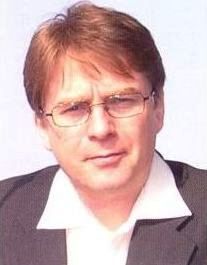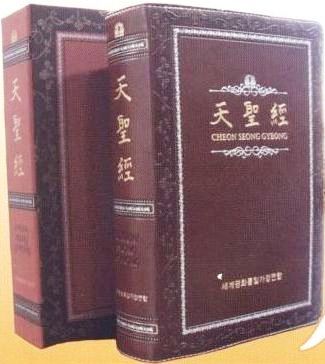![]()
The Words of the Gray Family
|
|
The Words of the Gray Family |

Question: How does the new Cheon Seong Gyeong differ from the original, published in English in 2006?
It has the same title, but this book is being made at a different providential time. My understanding is that the new Cheon Seong Gyeong is horn of True Parents' desire to guide us in building and settling Cheon Il Guk. A subtitle has been added to the work, The Holy Scripture of Cheon Il Guk. This scripture is appearing during the time of Cheon Il Guk, and it is dedicated to helping us open the gates of the kingdom.
The first three books of the new volume -- "God," "'True Parents" and "True Love" -- seem to refer to the original world. Books four, five and six correspond to the three blessings. Later books deal with personal growth and life in Cheon Il Guk. There is a book devoted to the peace messages and a book of Father's prayers spanning fifty years. Many of these features mean that the content is largely different from the original, making it an almost completely new work, with many new passages that will be seen in English for the first time.
The original Cheon Seong Gyeong was published in Korean in 2003 and distributed in 2004. It naturally contained very little of what Father said after 2000. The new version includes extracts from Father's speeches in the final years of his life, including extracts from public speeches and prayers until his final years, including his final recorded prayer -- which appears in the text in full. The work provides a very rounded view of Father's overall teachings, including the stages of True Parents' mission and the milestone providential events that marked its progress.
Some of the books of the original Cheon Seong Gyeong were compiled by a wonderful elder from the seventy-two-couple blessing group, a man deeply immersed in Father's teachings. The later Cheon Seong Gyeong was compiled, at True Parents' behest, by a group of our elders and theologians headed by two of the most trusted elder brothers (both former church presidents) from the thirty-six-couple blessing group, Rev. Young Hwi Kim and Rev. Jae Seok Lee. In both endeavors human effort was involved but behind this, one can sense God's desire to reach us.
Some text in the original Cheon Seong Gyeong was reprinted from other books that had been published. The text in Korean had already been edited by well-meaning editors to make it easier for a broad range of people to read. The original wording Father had used was sometimes changed and sometimes this perceptively altered the meaning. In that Father wholeheartedly embraced the work, this was clearly not a problem for him. But as time passes other books will be made and the issue of protecting the authentic teaching will always be there. For the new Cheon Seong Gyeong, the compilers went back to the original volumes of Father's speeches for their selections, so that -- even without Father physically present -- it conveys his authentic teaching.
Question: Could you please describe the new Cheon Seong Gyeong.
Cheon Seong Gyeong was created to be a foundational text, in the way we view Divine Principle. It is an anthology of True Parents' teachings, in the form of extracts from Father's speeches spanning more than fifty years, including his final years on earth. Divine Principle contains True Father's essential revelation; but it ends, abruptly, at the point where True Father's birth is predicted -- like the Old Testament in relation to Jesus. Cheon Seong Gyeong brings us the words spoken by the man and woman who's coming the Divine Principle foretells. They include the significance of blessed marriage, and the providential steps True Parents passed through to accomplish everything God had asked of them. The new version notably covers the providence over the past ten or fifteen years, including numerous declarations and providential milestones in True Parents' mission, for example their elevation to be king and queen of peace. It deals systematically with concepts we are engaged with, such as Home Church, Tong- Ban Gyeokpa, tribal messiahship and life as a citizen of Cheon Il Guk.
The work is laid out in thirteen books, plus additionally a special compendium of Father's prayers under thirteen chapter titles that mirror the thirteen books.
Question: Some people are calling this Mother's and the earlier version Father's Cheon Seong Gyeong.
Those are understandable monikers given the perceived influence each of the True Parents had on the respective volumes. Yet one fundamental issue arises: Doesn't Father and Mother's love transcend death? I feel that a couple that has reached so complete a relationship with God (as we marked on Foundation Day) would still be together even upon one of them departing this life. Knowing that Jesus communicates so intimately from the spirit world, I think Father also has many avenues. I can imagine one of his primary tasks would be to help True Mother accomplish True Parents' mission on earth. This book would therefore be his and Mother's initiative together.
Yet, even if it were Mother's sole initiative I would trust God to guide her closely based on their relationship.

Question: What challenges are there when translating such a text?
You cannot translate from one language to another unless you understand the speaker's intended meaning. Father had a unique speaking style and expressions that translators need to be familiar with. This was partly due to the need to express concepts originating beyond this earth plane through the imperfect medium of earthly language. So what Father says is not just hard to translate, it is hard even for Koreans to understand at times. Knowledge of Divine Principle, of the flow of God's providence through the years, and, yes, personal experience of listening to Father and translating what he says, are key to this craft.
One essential task is to translate accurately and express emotively. Translators are interested in accuracy, but editors are interested in beauty -- how expressive the text is. Readers also want text that stirs the heart when they read it. You can view this as the essential marriage of translating and editing.
Yet when you come to a scriptural work like this, it's not an easy marriage! You cannot always write everything Father says in a way that opens everyone's hearts and makes them feel light and breezy. A foundational scriptural work for Unificationism naturally deals with the providence of restoration for us as individuals and for humankind as a whole. Father emphasizes human responsibility. He is trying to save people from evil and speaks candidly: "You must succeed in this." There may be no easy way to make it sound exciting and joyful. Contrast that with the desire for a book that can move the heart and that people enjoy reading.
It is a foundational text, so it is bound to be weighty. It has a certain formality of structure and tone. Even in the original text, the Korean verb forms were made more formal. Later, I think this content will be the inspiration for other books, more popularized versions. There are various modern translations of the Bible, such as The Message.' Different versions were made to reach different demographics. But with Cheon Seong Gyeong, even the new version, I feel we are on a very foundational level.
Question: What point have you reached in the preparation of the text?
We have translated the entire book. We offered True Mother an interim publication of the book at the time of the anniversary of True Father's Seonghwa. Since then we have been working on reviewing the entire translation from beginning to end, and then editing the text. That process is more than halfway through, even though we are encountering genuine challenges in dealing with Father's sometimes very complex utterances.
Question: How difficult was it to find translators?
In a nutshell, it was and is difficult.
Question: You are English but the book will be in American English. What input came from America?
A team has been set up in the United States. We asked the American church for support and Dr. Michael Balcomb also sought us out, naturally being concerned that the translation into American English was being organized by an Englishman who had lived away from the West for two decades.
We were concerned that the project should not be done here in Korea without anyone from the American church involved. In the initial stages, individuals offered their services. Now the American church is taking ownership of the project. True Parents lived in the United States for years, and members have experience dealing with publications of Father's teachings going back three decades and more. And because members have supported the News World and the Washington Times, there is a tradition of dealing in good English. Moreover, some US-based Korean members are bilingual and they can offer a lot in the challenging task of checking and improving the English translations.
Question: What other challenges have you met in the course of this work?
Father is very forthright in his expression. Some of our theological views naturally distinguish the Unificationist view from that of other faiths. Father will sometimes teach such views very candidly. True Parents' revealed that Jesus should have had a family and that his return would not be a metaphysical event, and Father's candid expression of these points poses a challenge for the translator or editor wishing to convey the teaching in the hope that those with another view might be touched rather than offended. What Father may say to a group of members who understand his mission and experience his heart does not necessarily mean that the reader who has just joined our movement from another tradition will easily catch the heart behind what has now become a written expression of Father's utterance. That brings up the question of what tone to aim for. Cheon Seong Gyeong is called scripture, which indicates something written, but in fact, the origin of most of its text is Father's extemporaneous speech.
Question: I'm sure readers want to know when the work might be concluded.
We are trying hard to finish the book by the first Foundation Day anniversary next year, in February. However if it turns into an absolute deadline we will have to rush somewhat. True Mother's vision is for this book to be read by us members, and by people who are not members, for years, for decades, to come. Mother is deeply concerned with how well it is done, but as we know, there are sometimes time constraints based on God's providential timetable.
Those are understandable monikers given the perceived influence each of the True Parents had on the respective volumes. Yet this raises one fundamental issue: Doesn't Father and Mother's love transcend death? f feel that a couple that has reached so complete a relationship with God (as we marked on Foundation Day) would still be together even when one has departed this life. I can imagine one of Father's primary tasks would be to help Mother succeed in her mission on earth. This book would naturally he the result of Father and Mother's working together.
In its pages True Father reveals the God whose plan is for love to fill each human heart through our families and beyond, who defined the essential course of growth we must complete to realize this, and who has never given up coaching us one by one. Surely he would be speaking to us and healing the world through this work even if it were Mother's sole initiative.